|
Getting your Trinity Audio player ready...
|
Muddy Roads, Slacklining, Mesmerizing Sandstone Caves
Eager for a quick desert reprieve, I recently hopped in my car and ventured to Utah for a four-day excursion. After a long eight-hour road trip, we made it to Capitol Reef National Park and slept under the stars on BLM land along Notom–Bullfrog Road. The next morning we packed our bags full of cheddar cheese, rice, tortillas, plenty of water and a leaky WhisperLite to embark on a short backpack at Lower Muley Twist Canyon.
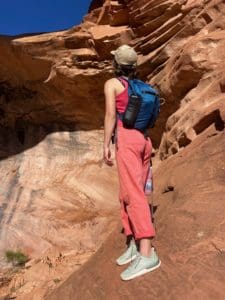
TropicFeel’s Canyon Desert Shoes and Cruiser Backpack in Utah’s Capitol Reef National Park. Photo by Claire Barber.
The backpacking route itself was relatively easy. Starting counterclockwise, we climbed the surrounding mesas. Losing the cairn trail only a handful of times, we dropped into a magnificent canyon for the next 10 miles. Flat, sandy, and looping through immense sandstone caverns the route was mesmerizing – the wash was scattered with geodes and the trail itself felt desolate. Compared to Zion or Arches, this part of Capitol Reef was much more similar to what you would find on BLM or Forest Service Land – the trail was less maintained, more than an hours drive out into the desert through washes and frequent washboards (we almost ran out of gas – yikes), and we bumped into only one other backpacking party.
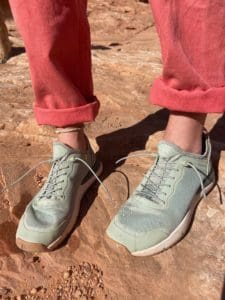
Photo by Claire Barber.
The lovely orange and yellow hughes made our trek slow. We oogled at all the rocks and the deep cuts through the valley.
The reality of the canyon hit us quickly – there was rain forecasted for the next day and camping in a wash with rain in the forecast is well…stupid. We fully planned to hike out of the canyon in a day, splitting the hike into rough 7 ½ mile segments. Lucky for us, we forgot to account for all the looping and winding that canyons do, so our visual estimates based off of the map where egregiously off. The canyon section which we started in (and had to complete in a day) was roughly 11 miles.
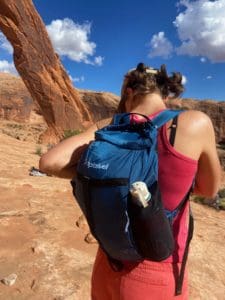
TropicFeel’s Cruiser Backpack. Photo by Claire Barber.
The next day was an easy, mucky four miles out. The rain hit earlier than expected. My feet hurt by the end – damp, white blisters and a funky toenail (you get the gist).
Driving out, our tank was dropping precipitously. The roads were already a mess. I was in the passenger’s seat, drying my feet out and avoiding looking at the gas gauge. We swerved, slid into a muddy ditch and rolled into town on zero.
My feet finally dry, I slid into a pair of Tropicfeel Canyon Desert shoes at the gas station. I spent the next three days testing them out as my camp and mellow hiking shoe for the trip.
That night at camp, I was happy with how easy the shoe was to take on and off. It’s “slipsock construction” was breathable and accommodating to my sockless, blistered foot. The shoes stayed surprisingly clean and kept my feet free of dust and grime. I hopped on a slackline and walked for a bit with the shoes on. My feet felt nimble, and as a camp shoe, they are light, packable, and convenient.
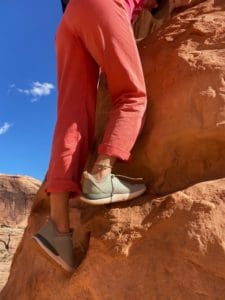
Photo by Claire Barber.
The next day we made our bid back to Moab. After setting up camp at Willow Springs, we decided to take a short hike at the Corona and Bowtie Arch Trail (about 2.5 miles). I was surprised with how good the traction of the shoe was on the sandstone. Compared to my traditional running shoes (Asics Gel Cumulus) the sneakers had way less slippage, but less support around the foot overall.
On the way up to the arches I strapped on Tropicfeel’s Cruiser Backpack. Built to be compact (it folds into a little pouch) I was skeptical that the pack would provide any support.
I weighed the pack down with simple essentials – rain gear and a fleece, snacks, two water bottles in either pocket, a headlamp, my camera. Sure it was sunny out, but I wanted to see if the pack could actually handle some average weight and bulk.
To my surprise, the pack was comfortable. There is thin black padding on the back and breathable padding at the straps. The top is rolled, which makes general accessibility a bit of a pain. The exterior pocket lies along the front of the pack, which becomes tricky to access if the pack is full of bulky items. The water bottle pockets are also sturdy and durable – they didn’t sag and the mesh stretched far over their sides to keep them firmly in place. The chest strap is also adjustable depending on your height and load, which is convenient if you plan to share pack-wearing responsibility with friends.
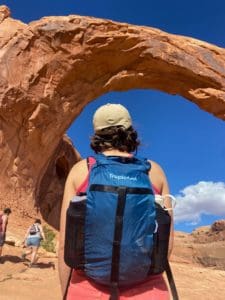
Photo by Claire Barber.
I usually hike with a Flash Pack 22 from REI. While that pack has a bit more bulk and a top brain exterior zipper, the pack is also far less portable than Tropicfeels’ design which packs down into a built-in pouch about the size of a Nalgene. If I was leaving for a 14 mile day hike and had both available, I would probably still opt for my 22 (built in water bladder accessibility), but if I was cramped for space in my suitcase, the Cruiser Backpack would get the job done.
For the hike overall, the sneaker proved durable, but the shoe’s sole lacks any pro-longed comfort or cushioning. The sole has holes for water drainage, which makes the shoe appealing for wet climates, but I wouldn’t take the shoe anywhere you wouldn’t take a regular running shoe. Yes, the traction is more impressive than what you would find on a typical sneaker, but its long-haul durability is sacrificed by stiff soles and thin, non-existant ankle support.
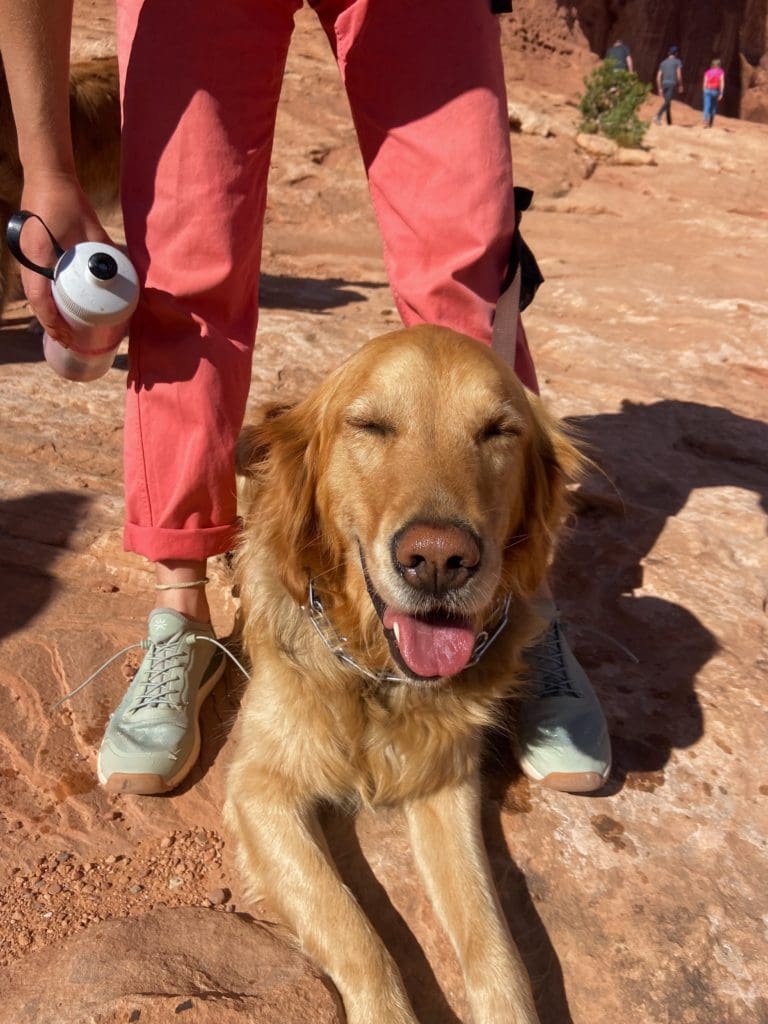
Photo by Claire Barber.
The limited cushioning aside, the shoe has convenient no-tie “sprint” laces. When you tighten the laces all the way though, wearer beware – the fabric on the shoe’s upper might bunch and rub against your foot umcofortably. If you take an extra second to straighten out the fabric while you tighten the shoe, problem solved.
Overall, TropicFeel’s products faired well in the desert. I was most impressed by the Cruiser Backpack – I will definitely be taking it on adventures in the future. The Canyon Desert Shoes also served their purpose, although I wouldn’t wear them for anything very strenuous. The sneakers are built for urban and outdoor crossover (stylish enough to wear out to coffee, and durable enough to wear slacklining or along a streambed), but they’re not suited for long-hual backcountry trips. If you need a shoe that doesn’t take up much space in the suitcase and is versatile –urban to adventure– the Canyon Desert could be for you. Pair it with the Cruiser Backpack and you’re set for some moderate outdoor romps.
The all-terrain sneaker category was born to meet the needs of modern day travelers who desire to always be ready to jump into a new adventure anytime, anywhere. Keeping this in mind, TropicFeel have designed Canyon, their best travel shoe yet.
Popular Articles:
Adventurer’s Guide To Capitol Reef National Park, Utah
Top Adventure Sports Towns: Moab, Utah
Slainté: Highlining The Old Man of Storr
Adventurer’s Guide to Grand Canyon National Park, Arizona
Adventurer’s Guide To Black Canyon Of The Gunnison
How to Spend 57 Hours in Red Rock Canyon, Nevada as a Rock Climber












